- Quick Read
- Deep Read ( 6 Min. )
Monitor Daily Podcast
- Follow us:
- Apple Podcasts
- Spotify
- RSS Feed
- Download
TODAY’S INTRO
‘The end of a beginning’
They melted down Robert E. Lee in secret. The bronze statue of the Confederate general on a horse that stood in Charlottesville, Virginia, for nearly a century, that is.
Swords Into Plowshares, the nonprofit that owned the statue, was concerned about violence if the deed had been public. So it trucked the statue to an out-of-state foundry where it was cut up and turned into bronze ingots. The nonprofit announced that at a Thursday news conference.
This is the Lee statue that was at the center of a white supremacist rally protesting city removal plans in 2017. The rally turned deadly when a neo-Nazi rammed and killed a counterprotester with his car.
Charlottesville then fought against legal efforts to preserve the monument. The city finally hoisted it off its stone plinth in 2021. Then they donated it to a coalition that proposed to melt it and repurpose it into new public art.
Why plan such a dramatic transformation? Why not just warehouse the statue?
Because taking a monument down should be as ceremonial as putting it up, said members of the Swords Into Plowshares initiative on Thursday. That gives the community a chance to recognize that it, itself, has changed.
“Creativity and art can express democratic, inclusive values. We believe that art has the potential to heal,” said Jalane Schmidt, a religious studies professor at the University of Virginia and project leader.
Swords Into Plowshares is just starting the selection of a jury that will, in turn, pick an artist or group of artists to make replacement artwork.
“We have a lot of work to do,” said Ms. Schmidt. “This is the end of the beginning.”
Share this article
Link copied.

Help fund Monitor journalism for $11/ month
Already a subscriber? Login

Monitor journalism changes lives because we open that too-small box that most people think they live in. We believe news can and should expand a sense of identity and possibility beyond narrow conventional expectations.
Our work isn't possible without your support.
In Maine, a community mourns – in lockdown
The largest mass shooting incident in Maine leaves a community shell-shocked and, because of a lockdown and search, unable to gather and mourn together.

In the aftermath of Maine’s worst mass shootings on Wednesday, a constant refrain has been heard in Lewiston, where the shootings occurred: We thought it could never happen here. Until it did.
And when it did, a shell-shocked community found itself angry, anxious – and atomized.
The suspect, a U.S. Army reservist named Robert Card, is still at large, so residents in Lewiston and nearby towns have been told to shelter in place. The streets are deserted; businesses and schools are closed. Grieving for the 18 people killed and the processing of the trauma of those who fled the attacks are happening behind closed doors.
Unwittingly or not, the shooter that terrorized Lewiston struck at two commercial venues where bowling and social games brought people together and built bonds.
Joey Walker was the manager at Schemengees Bar and Grille when he was shot and killed Wednesday night. He ran the darts league, the billiards games, and the cornhole league.
“He was a great son. He loved a thousand [people] ... and a thousand of them loved him back,” says his father, Leroy Walker Jr. “He had the biggest heart in the world.”
In Maine, a community mourns – in lockdown

In the aftermath of Maine’s worst mass shootings, a constant refrain has been heard: We thought it could never happen here. Until it did.
And when it did – after a man armed with a semi-automatic rifle sprayed bullets at families out bowling and, minutes later, at adults relaxing at a bar on a warm Wednesday night – a shell-shocked community found itself angry, anxious – and atomized.
The suspect, a U.S. Army reservist, is still at large, pursued by local, state, and federal law enforcement, so residents in Lewiston and nearby towns have been told to shelter in place. The streets are deserted; businesses and schools are closed. Grieving for the 18 people killed and the processing of the trauma of those who fled the attacks are happening behind closed doors.
A broader reckoning with the enormity of the crime – and the fact that it happened here in Maine, a state with a population of 1.3 million, permissive gun laws, and low levels of violent crime – has yet to ripple outward. But questions are already being asked about why Robert Card, the suspect who reportedly had serious mental health problems that required a formal evaluation, still had access to firearms.
State police said Mr. Card had abandoned a vehicle at a boat landing in Lisbon on Wednesday night, hours after the shootings that also injured 13 people, three critically. A heavy police presence in the area was scaled back on Thursday, as the search widened and divers were called in, and some residents began to leave their homes.

“We’re all holding our breath and hoping he’s caught,” says Meranda Delnegro, as she pushes a stroller outside her apartment building in Lisbon. She notes that Maine is “one of the safest states” in the United States, but she adds, “I’m feeling a little uncertain now.” When she held a baby shower two years ago, the venue was the bowling alley that the shooter attacked first.
Ms. Delnegro, who grew up in Lewiston and works there as a medical assistant, says it’s a city that cares for its own. “Lewiston is open-hearted. You go out of your way to help people,” she says.
Earlier that day, Maine Gov. Janet Mills told a news conference in Lewiston that she felt deeply for a community where she met her husband and raised her daughters. “This city did not deserve this terrible assault on its citizens, on its peace of mind, on its sense of security. No city does. No state. No people,” she said.
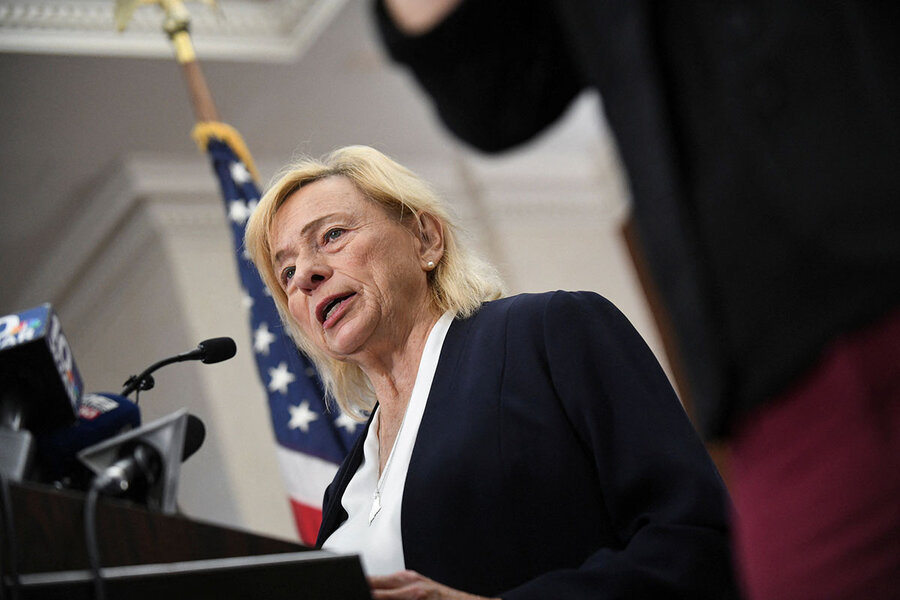
“A resilient and caring people”
Governor Mills spoke of a “dark day” for Maine that struck at “the very heart of who we are.” She added, “We are a resilient and caring people. In the days and weeks ahead, we will need to lean on those qualities more than ever before.”
On Friday, Maine Department of Public Safety Commissioner Michael Sauschuck was asked at a news conference about whether an extended shelter-in-place policy could delay the recovery process for the community after such a traumatic event. Mr. Sauschuck said that bringing the suspect to justice was the priority, but that healing must happen next. “It’s going to take a while for the community to work through this. It’s going to take a lifetime for the families,” he said. At the end of the day, he announced that the policy has been rescinded, effective on Saturday, though hunting in the area is prohibited.
For Leroy Walker Jr., Wednesday night was a long, sleepless nightmare that began with a phone call just after 7 p.m. “My youngest son called me up and said, ‘Dad, something’s going on at Schemengees. I think a gunman went in and shot my brother.’ I almost fell apart,” he says.
Schemengees Bar and Grille Restaurant was the second shooting site. Joseph “Joey” Walker was the manager and was working on Wednesday. His father had to wait until mid-morning Thursday to learn from state police that Joey had been shot dead. He died with a butcher’s knife by his body, presumably after trying to tackle the shooter, a police major told him.
“The ambulance people said when they went in it was like walking on marbles. The floor was so covered with shells from the gun,” he says.
Standing near his apartment in Auburn, the twin riverside city to Lewiston, Mr. Walker spoke of his son’s deep ties to the community. Yes, Joey managed the bar, but not just the bar. He ran the darts league, the billiards games, and the cornhole league on Wednesday nights.
“He was a great son. He loved a thousand [people] from these two cities, and a thousand of them loved him back,” he says. “He had the biggest heart in the world.”
Recreational games leagues are part of the social glue that holds communities together, and their demise has been lamented by sociologists tracking America’s political polarization and the estrangement felt within communities. Unwittingly or not, the shooter that terrorized Lewiston struck at two venues where bowling and cornhole brought people together and built bonds.
A police bulletin issued after the attacks said Mr. Card had been committed to a mental health facility for two weeks over the summer after “hearing voices and threats to shoot up” a military base, The Associated Press reported.
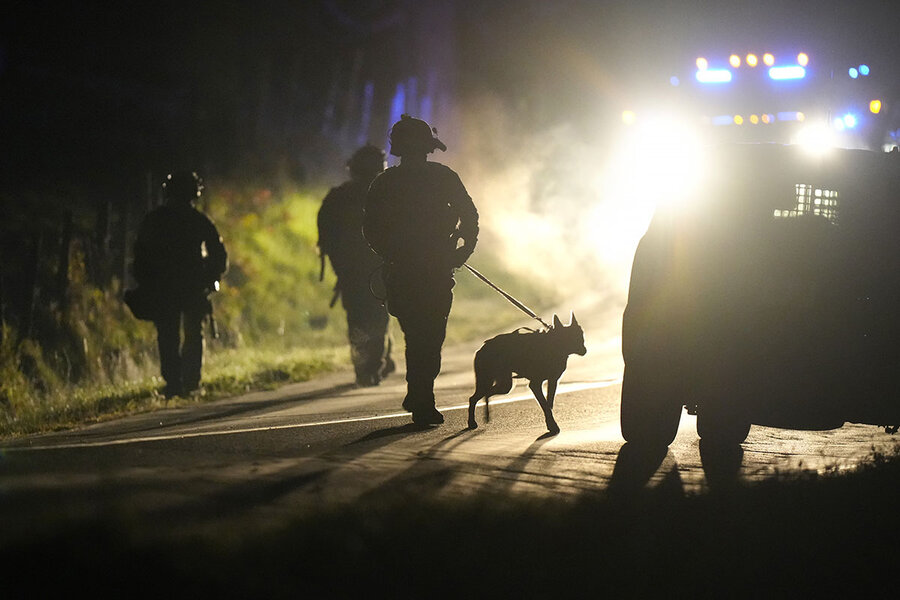
Mind changed on assault rifle ban
Mr. Walker, a city councilor and a retired parks superintendent, says he can’t begin to understand the killer’s actions or why his mental health evaluators didn’t intervene. “I don’t have the answers. I just wish my son was here,” he says.
Democratic Rep. Jared Golden, a former Marine who represents Lewiston and surrounding towns, said Thursday that he had changed his mind on assault rifle ownership. Speaking at the same podium where Governor Mills had spoken earlier, he said he would work in Congress to pass federal gun control laws, after previously opposing his party’s efforts. His opposition, he said, represented “a false confidence that our community was above this, and that we could be in full control,” among other misjudgments.
“To the people of Lewiston, my constituents throughout the 2nd District, to the families who lost loved ones, and to those who have been harmed, I ask for forgiveness and support as I seek to put an end to these terrible shootings,” he said.
Pro-gun groups argue that AR-15-style rifles are useful for self-defense and hunting. Robert Spitzer, a political scientist and author of “Guns Across America: Reconciling Gun Rules and Rights,” says this week’s events underscore that their main purpose is as an offensive weapon. “This event punctures the notion that these weapons are just as good for self-defense and hunting as other weapons.”
Professor Spitzer adds that the killings in Lewiston, the deadliest in the U.S. since the Uvalde, Texas, school shooting in May 2022, “raises the question of civilian access to military-style weaponry with large capacity magazines. It brings that debate into Maine.”
Mr. Walker and his son used to run the darts league at a social club in Auburn before it moved to Schemengees. Some years back, they discussed installing metal detectors on the doors. “We talked about what would happen if a gunman came down here and started shooting,” he says.
Still, there was a sense that such things didn’t happen here. “We never did it. But we talked about it,” he says.
Staff writer Patrik Jonsson contributed to this story.
Editor's note: This story has been updated to reflect that the shelter-in-place policy has been rescinded, effective Saturday.


Israeli, Palestinian pro-peace groups cautious, not cowed
With war, some Israeli and Palestinian peace activists are hunkering down. Others, including victims of Hamas, are doubling down and demanding a cease-fire. None are giving up.
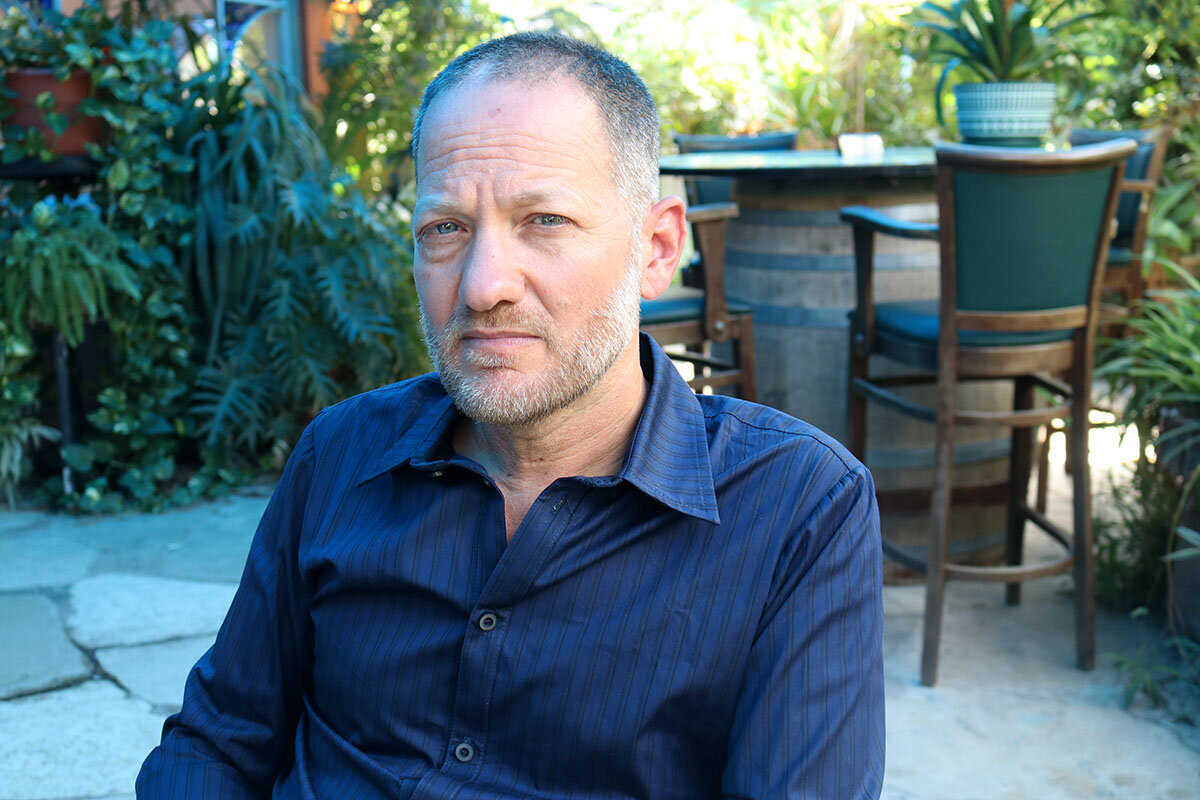
- Quick Read
- Deep Read ( 5 Min. )
-
Taylor Luck Special correspondent
Moaz Inon’s parents and best friend were killed in their homes on Oct. 7, when marauding Hamas attackers raided southern Israel.
Yet he has not had time to grieve, he says, because he is consumed by a mission: to stop a war and send a message of peace. “Only hope can extinguish extremists and this cycle of bloodshed,” Mr. Inon insists. “It will not be by opening a new front or another invasion of Gaza.”
These are difficult days for members of the peace camp, both Palestinians and Israelis, as polarization sets in.
“Both sides are crying out with intense pain, a consuming rage, and a rejection of the other side,” says Rami Elhanan, who has been a peace activist since he lost his 14-year-old daughter to a Hamas bomb on a Jerusalem bus 25 years ago.
Some peace activists are hunkering down. Some, like Mr. Inon, are doubling down. But none are giving up.
“If this war escalates, our role will be more important than ever,” says Sally Abed, a member of Standing Together, a pro-peace organization. “We will never stop because the only path forward is accepting that we have a shared homeland, a shared fate, a shared pain, and a shared experience.”
Israeli, Palestinian pro-peace groups cautious, not cowed
Since his parents, Bilha and Yaakobi, and his best friend were killed in their homes by Hamas attackers who raided southern Israel on Oct. 7, Moaz Inon has not had a moment to grieve.
He is consumed with a mission, he says: to stop a war and send a message of peace. “Only hope can extinguish extremists and this cycle of bloodshed,” he insists. “It will not be by opening a new front or another invasion of Gaza.”
Mr. Inon, a longtime advocate for peaceful coexistence between Israelis and Palestinians, runs cross-cultural tourist trips to Arab towns such as Nazareth. For the time being, though, those trips are off.
In the shadow of a pending Israeli ground assault on the Gaza Strip, and amid the deepest polarization between Palestinians and Israelis for decades, these are difficult days for members of the peace camp.
“We are trying to navigate a closing space at the eye of the storm to de-escalate tensions,” says Sally Abed, a Palestinian Israeli director of Standing Together, a grassroots organization gathering Jews and Arabs. “At times it does feel bleak.”
“Both sides are crying out with intense pain, a consuming rage, and a rejection of the other side,” says Rami Elhanan, who lost his 14-year-old daughter to a Hamas bomb on a Jerusalem bus a quarter of a century ago.
“There aren’t many people who are capable of hearing in the middle of all this that we share a common humanity and all deserve peace,” he acknowledges.

Mr. Elhanan belongs to Parents Circle-Families Forum, an organization of parents and relatives of young people killed in the violence of the Israeli-Palestinian conflict. He says the two decades that he has spent promoting its message of peace saved him from a life of bitter hatred of Palestinians after his daughter’s death.
Parents Circle has suspended its activities, reflecting a wider pause in public events by other peace-building organizations. Sometimes that pause has been enforced by the Israeli authorities: Israeli police broke up a Standing Together rally in Jerusalem last week, imposing fines on participants.
Some peace activists are concentrating on at least keeping open channels of communication within their organizations, so as to maintain the solidarity and support they will want to call on when the time for broader outreach returns.
“From Day 1 [following the Hamas attack] we began to call our Israeli brothers and sisters to make sure they are safe and to say we support them,” says Bassam Aramin, a Palestinian member of Parents Circle who bonded with Mr. Elhanan (“my brother!”) after his 10-year-old daughter was shot and killed by an Israeli border guard in 2007.
With Palestinians under lockdown in the occupied West Bank, Zoom calls between peace activists have proliferated.
At the same time, some say that with emotions so raw, and intercommunal dialogue on hold, now is a time for each side to focus first on its own well-being.
“It’s not a matter of segmentation or a denial of the other’s pain, but this is a time to hear our own communities and keep the values we are based on alive as we address the pain,” says Antwan Saca, director of Palestinian programs at Seeds of Peace, a group that trains youth leaders in Israel and the Palestinian territories. “I see it as the emergency aid we can provide right now.”
“The shock of what occurred caught us just as we were getting our programs in full swing,” says Shaul Judelman, Israeli co-director of Roots, an organization that works through religious leaders of different faiths to influence young people.
“People have had to face things on each side that are very hard, to the point where making space for dialogue and hearing the other – I don’t know where it can come from,” Mr. Judelman says. “So yes, for right now we are stepping back.”
That has not meant inaction. “You deal with trauma by doing, so that’s where we are right now,” says Mr. Judelman, who has organized patrols to paint over “revenge” graffiti proliferating in his West Bank community, and collected supplies such as baby formula and food for Palestinian families.
He wonders, though, what more he and people like him could have done to forestall the current descent into unbridled violence. “Now we see that even with everything we did, we didn’t work hard enough for peace,” Mr. Judelman says.

But the peace and reconciliation community had been facing stiffer head winds well before the shock of Oct. 7. Far-right members of Prime Minister Benjamin Netanyahu’s government had ramped up action against pro-peace groups – for example, banning Parents Circle from giving talks in high schools, something the group had done for 20 years.
Mr. Inon takes that kind of attitude as a challenge to be met. “When I hear the voices of apartheid and revenge, I understand that I have a mission,” he says. “I don’t have time to grieve [for my parents and friend] because if our cry can’t be heard, then the catastrophe will be much greater.”
“This kind of radical empathy is one of the most important voices in Israel right now,” says Ms. Abed. “Out of the loss, the pain, the grief they are calling for peace and a cease-fire.”
Her group, Standing Together, is working with relatives of those who died in the Oct. 7 massacre to “amplify their voices.” It is also helping both Arabs and Jewish evacuees, and organizing joint Jewish-Arab hospital visits to survivors of the attack.
In Haifa, a diverse city, Standing Together has mapped out and renovated public bomb shelters to be used by both Jewish and Arab Israelis should Hezbollah be drawn into the war and fire missiles from nearby Lebanon.
“If this war escalates, our role will be more important than ever,” says Ms. Abed. “We will never stop because the only path forward is accepting that we have a shared homeland, a shared fate, a shared pain, and a shared experience.”

Five years after Tree of Life attack, a sense of isolation among US Jews
Five years ago today, the Tree of Life synagogue shooting became the worst antisemitic attack in U.S. history. In Pittsburgh, Jews say they are lonelier and more afraid now – a shift from the way the community rallied around them in 2018.

- Quick Read
- Deep Read ( 5 Min. )
Jordan Golin reflects on his community’s experiences five years ago today, when the Tree of Life synagogue endured the deadliest act of antisemitic violence in U.S. history. Amid the grief and horror, he also remembers feeling strangely reassured.
“When the attack happened five years ago, it was obviously a very painful, very challenging experience, but it was also a very complex experience,” says Mr. Golin, head of Jewish Family and Community Services Pittsburgh. His organization was among the first responders to synagogue members’ emotional needs after a white nationalist gunman killed 11 worshippers.
Muslim groups helped raise almost $200,000 to help the synagogue bury its dead while offering to stand guard. Christian congregations offered invitations to their churches and provided gifts and support.
“They could relate to the horror of having an act like that taking place in a sanctuary, in a holy, supposedly safe setting,” he says. “Knowing that, you know, the larger community is there for us ... there was something very healing about that.”
This October, however, Mr. Golin says they feel a sense of isolation and even fear after the Hamas attack on Israeli civilians and Israel’s bombing of Gaza – as well as surprise at the very different reactions of neighbors who had been so supportive.
Five years after Tree of Life attack, a sense of isolation among US Jews

Jordan Golin reflects on his community’s experiences five years ago today, when the Tree of Life synagogue in Pittsburgh endured the deadliest act of antisemitic violence in U.S. history. Amid the grief and horror, he also remembers feeling strangely reassured.
“When the attack happened five years ago, it was obviously a very painful, very challenging experience, but it was also a very complex experience,” says Mr. Golin, president and CEO of Jewish Family and Community Services Pittsburgh. His organization was among the first responders to synagogue members’ emotional needs after a white nationalist gunman killed 11 worshippers and wounded several others, including a number of Holocaust survivors. The gunman was found guilty this summer of 63 counts, including hate crimes, and the jury in August recommended he be sentenced to death.
“So there was something that was, in an odd way, kind of reassuring by the outpouring of support that we received,” he says. Muslim groups, especially, helped raise almost $200,000 to help the synagogue bury its dead while offering to stand guard at the place of worship. Christian congregations reached out and offered invitations to their churches while providing gifts and support.
“They could relate to the horror of having an act like that taking place in a sanctuary, in a holy, supposedly safe setting,” he says. “Knowing that, you know, the larger community is there for us, just thinking about us, is concerned for us through something that was very devastating – there was something very healing about that.”
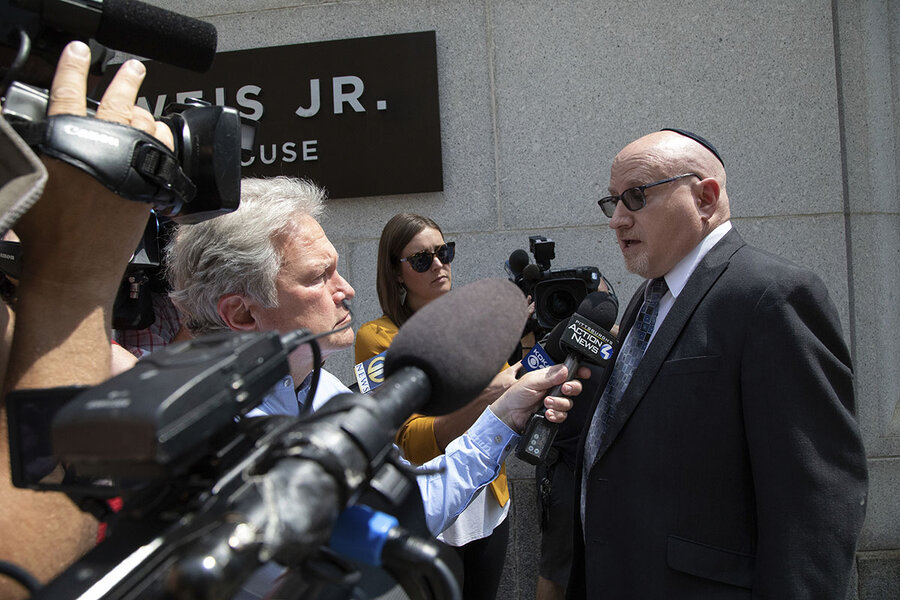
This October, however, Mr. Golin and others say they feel a sense of isolation and even fear after the Hamas attack on Israeli civilians and Israel’s continued bombing of Gaza – as well as surprise at the very different reactions of neighbors who had been so supportive.
As in much of the country, there have been instances of antisemitic graffiti on school properties in Pittsburgh. According to the Anti-Defamation League, the number of antisemtic incidents since Oct. 7 has spiked 388%, with 312 incidents documented through Oct. 23, more than half linked to the war in Gaza.
At the same time, too, the Council on American-Islamic Relations reports that it has also seen a spike in anti-Muslim incidents, saying it has received 774 complaints since Oct. 7, the most in three weeks since 2015.
“There’s a very different vibe going on now,” says Mr. Golin. “Political beliefs, political ideology, foreign policy shouldn’t impact the behavior between neighbors, but it kind of does. Conversations are very difficult because it’s hard to keep separate the politics of the Middle East with the lives of American Jews. And so that sense of, where are all the other neighbors who told us that they were there for us? Where are they now? Especially just as we’re coming up to the fifth commemoration, that’s especially hard for many members of the community.”
The climate on college campuses also remains tense as students rally in competing protests and demonstrations in support of Hamas or Israel, each condemning the other as holding murderous views.
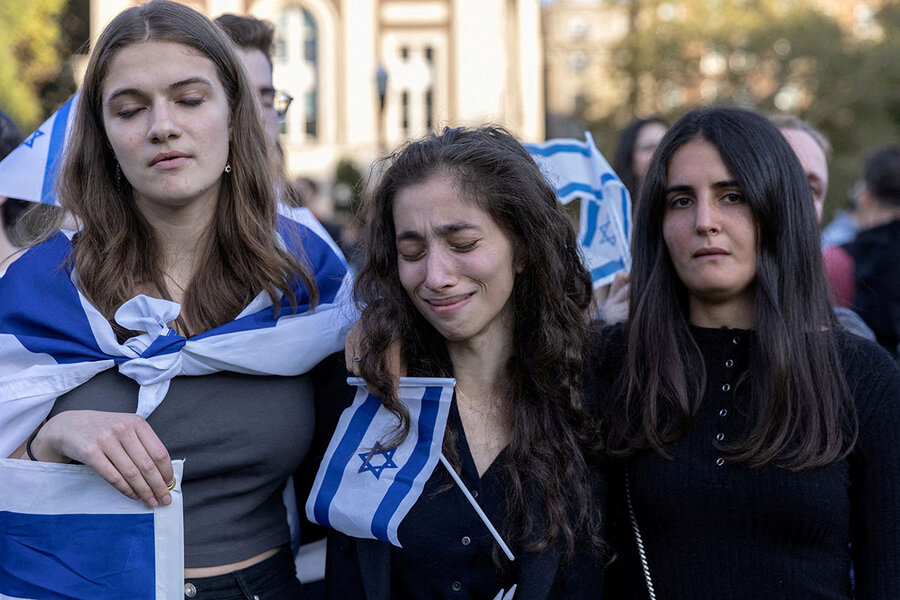
On Wednesday, during a citywide student walkout in support of Palestinians, a group of Jewish students at Cooper Union college in New York took refuge in the library after a confrontation with pro-Palestinian protesters. Custodians locked the doors as protesters marched through the halls singing “Free Palestine” and banging on the library doors, alarming the Jewish students inside.
Even before the Hamas attack, nearly 60% of Jewish college students said they’ve witnessed or experienced antisemitism this year, according to an Ipsos survey in September.
Among professors, the war in Gaza has had a deep impact on personal and professional relationships, says Aram Sinnreich, chair of the communications studies division at American University in Washington.
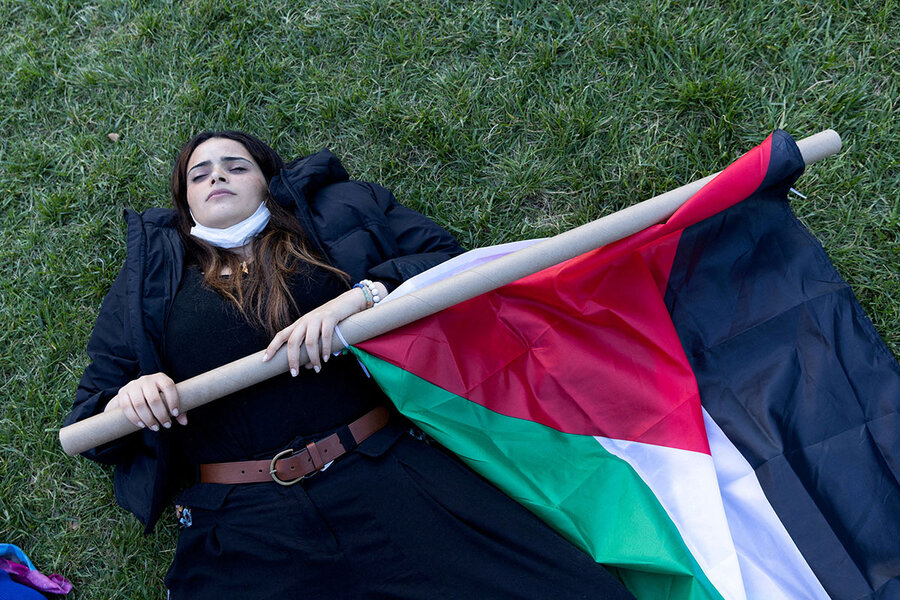
Dr. Sinnreich condemns both the Hamas attack against civilians and the Israeli bombing of civilians as “war crimes.” But such a position has put him and others in the crosshairs of those on both sides who would justify the violence and resulting casualties.
“There is a widespread sense of betrayal among Jewish and Muslim leftists who believed themselves to be in the company of sensitive and sympathetic friends and colleagues, and found out only too late that they were viewed through this flattening and totalizing lens that equated them with the horrific actions of their ostensible tribe,” he says.
American University, too, has had anti-Muslim and antisemitic incidents on campus over the past few weeks. A Palestinian staff member received a threatening and hate-filled note, the university reported. In a residential hall, students found swastikas and a Nazi slogan graffitied on two room doors and in a bathroom.
“I and every other diasporic Jew that I know feels personally threatened when we see that kind of vandalism and when we see people nakedly espousing antisemitic ideas and language and imagery in public,” Dr. Sinnreich says. “And that’s its function, to knock us back on our heels and put us into a defensive posture.”
Even in academia, he says, people do not disambiguate being a Jewish scholar from being a supporter of Israel, or a Muslim scholar from a supporter of Hamas. This disrupts a stand against what he calls “the genocidal assaults on thousands of innocent civilians” on both sides.
“It is an ongoing emotional balancing act to try to hold that truth in our hearts while simultaneously seeing ourselves treated as scapegoats and potential collateral damage by [those] who fail to recognize our humanity,” he says.
Last week, however, groups of Jewish and Muslim high school students in New York decided to try a different way.
Members of the student-led Muslim Student Association and Jewish Student Union at Millennium Brooklyn High School (MBHS) had both been deeply affected by the unfolding tragedies in Gaza and Israel, some having family members in both areas.
So they got together with a few faculty members and a counselor and hashed out a statement focusing on their common lives.
“During this time, we understand that hatred and discrimination may be on the rise,” their joint “Solidarity Message” reads. “Our two clubs strive to uphold the most important values of MBHS and never condone the spread of anti-semitism, Islamophobia, or discrimination of any kind. Instead, we aim to emphasize the importance of humanity.
“We urge all students of MBHS to be mindful of their words and actions, and to ensure that they do not incite fear or make other students feel targeted or unsafe,” the statement continued. “Collectively, we have the social obligation to be sensitive to the experiences of others, and we should all understand that for many of us in the community, this is personal.”

Podcast
Why a close watcher of Gaza crisis sees a sliver of hope
The Oct. 7 attack by Hamas drove the Israeli-Palestinian conflict to a new level. Can that spark a focus – finally – on finding some political resolution? Our longtime analyst joins our podcast to discuss.

An analyst of global affairs, Ned Temko has kept the Palestinian-Israeli conflict near the top of his watch list for more than four decades.
He’s seen a lot. The current flare-up in Gaza, which began with the cross-border attack on Israel by Hamas on Oct. 7, is a chapter in a story that dates to Israel’s founding in 1948. It’s also like nothing Ned has yet seen, he says on the Monitor’s “Why We Wrote This” podcast.
“This is unique in my coverage of Israel over the years,” Ned says. “There is a real trauma, real rage, over what happened.”
The new ferocity “has stripped back decades of conflicting narratives ... to their bare essentials,” Ned says. “Both sides feel immensely vulnerable, immensely uncertain, and immensely angry, and that makes it even more complex.”
Along with new volatility have come new questions about how to move forward. Remarkably, perhaps, Ned says he sees a sliver of hope. He has watched this story on a human level from both perspectives. He has seen what has been tried.
“I think what’s different this time around is the ... visceral sense in which people on both sides have felt that this conflict is inescapably part of their lives, and not in a good way,” Ned says. “That there is, for each of them, a dawning realization that their own interests in a stable, secure existence ... depends on some sort of resolution of this core dispute.” – Clayton Collins and Jingnan Peng
You can find story links and a transcript of this audio interview here.
Mideast Turmoil: What’s Different This Time

Gourmet eateries thrive near national parks
Forget bagged lunch and s’mores. The culinary scene outside national parks has evolved in recent years, delighting taste buds and giving visitors another reason to make the trek.

- Quick Read
- Deep Read ( 5 Min. )
As the sagebrush-blanketed landscape of eastern Nevada gives way to pine-covered peaks, a tiny town pops up along State Route 487.
This is Baker, home to 30-some residents. Two of them trained at the now-closed California Culinary Academy.
Twin sisters Cheri Phillips and Tabitha Degnan operate Sugar, Salt & Malt Restaurant. The unassuming eatery sits on the outskirts of Great Basin National Park, giving visitors and locals alike a gourmet experience in the middle of a literal food desert.
“You walk in the door, and you hear the nice music, and you sit down and get waited on, and you have good food,” Ms. Degnan says. “The dining experience from end to end is so much more than just handing someone a hamburger.”
As national park popularity grows, so do related businesses. That includes restaurants creating culinary scenes in hard-to-reach locales.
Melissa Strong owns two eateries in Estes Park, Colorado, outside the entrance to Rocky Mountain National Park. Ms. Strong says one of those, Bird & Jim, has seen sales double since the restaurant opened in 2017, a feat she attributes to offering the food and atmosphere visitors and locals are seeking.
“Come on in, in your hiking boots and your hiking clothes and dirty,” she says. “Celebrate what you just did.”
Gourmet eateries thrive near national parks
If you’re planning a trip to Great Basin National Park, pack some water and snacks for the road.
There isn’t a Starbucks, a McDonald’s, or even many gas stations along the miles and miles of two-lane roads cutting through the desert. But as the sagebrush-blanketed landscape gives way to pine-covered peaks, a tiny town pops up along State Route 487.
This is Baker, home to 30-some residents. Two of them trained at the now-closed California Culinary Academy.
Twin sisters Cheri Phillips and Tabitha Degnan operate Sugar, Salt & Malt Restaurant. The unassuming eatery sits on the outskirts of the park, giving visitors and locals alike a gourmet experience in the middle of a literal food desert.
“You walk in the door, and you hear the nice music, and you sit down and get waited on, and you have good food,” Ms. Degnan says. “The dining experience from end to end is so much more than just handing someone a hamburger.”
It’s a far cry from a bagged lunch or s’mores around a campfire, but as national park popularity grows, so do related businesses. That includes restaurants creating culinary scenes in hard-to-reach locales. Ms. Degnan and Ms. Phillips saw an opportunity in 2020, when they purchased a restaurant building in Baker and rebranded it as their own. Today, it comes complete with cafe lights strung above an outdoor patio, a bar and dining area inside, and a coffee shop in an adjoining sunroom.
Great Basin National Park, known for its dark skies, ancient bristlecone pine trees, and limestone caves, has seen a visitation surge in recent years. A decade ago, about 92,000 people entered the park each year. Now, it welcomes north of 142,000 visitors annually.

They represent a small slice of the 312 million park visitors across the United States, who, in 2022, spent an estimated $23.9 billion in so-called gateway regions bordering the natural wonders. Nearly 20% of that spending went to restaurants, trailing only lodging, which accounted for about 38%.
Whether park visitors are clamoring for fine dining, adventurous eats, or comfort food is an open-ended question. But it’s likely that a meal out is on their itinerary. Cassidy Jones, senior visitation program manager for the National Parks Conservation Association, says more visitors want “structure and predictability” to their trip, meaning they’re supportive of efforts such as park entry reservations, which manage access and congestion.
A structured trip as opposed to a wandering visit may lend itself to a day packed full of activities in and around the park itself.
“I know that I’m getting in at this time, and then these are the other things that I have booked, and this is how my itinerary is going to go,” Ms. Jones says, referring to the thought process.
And for some, that to-do list may include a pre- or post-hike meal.
Melissa Strong owns two eateries in Estes Park, Colorado, outside the entrance to Rocky Mountain National Park. The Bird’s Nest, a grab-and-go cafe, offers “picnic backpacks” filled with vegetables, meats, cheese, and bread for parkgoers as they embark on their outdoor adventures. Bird & Jim, billed as “modern mountain dining,” sits across the street and serves menu items such as smoked pheasant chowder, lamb bolognese, and a “carnivore” entree featuring elk striploin, miso beef short ribs, and game sausage.
Ms. Strong says Bird & Jim’s sales have doubled since the restaurant opened in 2017, a feat she attributes to offering the food and atmosphere visitors and locals are seeking.
“Come on in, in your hiking boots and your hiking clothes and dirty,” she says. “Celebrate what you just did.”
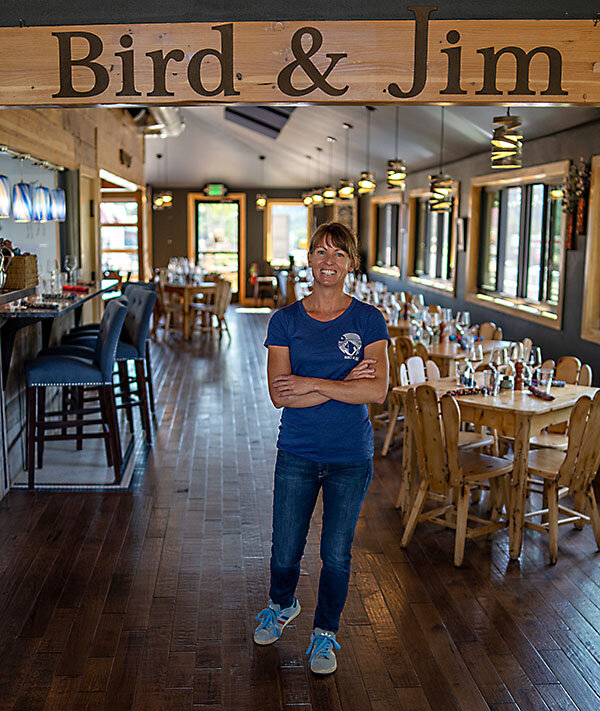
As the demand grew, the logistics of operating a restaurant in the mountain town became easier, Ms. Strong says. Years ago, one or two food distributors would make a single trip up the hill each week, limiting what restaurateurs could offer customers. Now, multiple distributors journey to Estes Park, expanding menus as a result.
“We do have a seasonally changing menu,” she says. “You come visit us in January, you come visit us in July, and you’re going to have two different experiences.”
While Bird & Jim operates year-round, other restaurants outside parks follow seasonal schedules. Sugar, Salt & Malt, for instance, opens in early April and closes at the end of October.
The expanding culinary scenes outside national parks doesn’t mean that comfort food is obsolete. Brian Hays, one of the owners of Canyon Pizza Co. in Moab, Utah, says the group specifically chose to open a pizzeria because pizza is a popular food that generally falls at an affordable price point.
Mr. Hays, who also works as a ranger within a national park, says he has friends drawn to Moab in part for its burgeoning food options. But pizza is a staple that people tend to crave after a day exploring the nearby Canyonlands National Park.
“If you ride bikes all day, go climbing all day, go trail running all day, it’s just the kind of food that works well in a town like this,” he says.
Back in Baker, Cindy and Greg Dewey decided to forgo their picnic lunch after a hike in Great Basin National Park. Instead, they ate sandwiches at Sugar, Salt & Malt.

The couple regularly visit national parks and have made it a point to try neighboring restaurants. The Deweys say they have been pleasantly surprised to find gourmet-style food in many of the small towns bordering parks.
“It has gotten very ‘bougie,’” Ms. Dewey says, referring to the food scene outside Zion National Park in Springdale, Utah.
After working in high-end restaurants in places such as the Florida Keys and Vail, Colorado, Ms. Phillips and Ms. Degnan of Sugar, Salt & Malt decided to move closer to where they grew up in Utah. They started a catering and coffee-cart business, which later morphed into the restaurant in Baker. During the first season their restaurant was open, they changed the menu almost weekly, gaining a sense of customers’ preferences.
“They wanted steak. They wanted fish. They wanted nicer items,” Ms. Degnan says. “They didn’t want just cheap food.”
Nowadays the menu consists of items such as braised lamb ribs, smoked tri-tip, and lasagna. But they leave room to innovate for special occasions, such as the recent solar eclipse, which drew spectators to the region’s dark skies.
Ms. Degnan described it as a day to “pull out the tablecloths and polish the silverware.”
On the eve of the eclipse, 60 people packed the remote restaurant for a four-course meal featuring corn chowder, butternut squash ravioli, New York strip steak with gorgonzola gnocchi, and crème brûlée, Ms. Phillips says.
Consider it dinner and a show.
Other headline stories we’re watching
(Get live updates throughout the day.)The Monitor's View
Lessons from a bounce-back nation
- Quick Read
- Deep Read ( 2 Min. )
-
By the Monitor's Editorial Board
The head of the European Central Bank, Christine Lagarde, praised the Greek people this week for their “remarkable” resilience. No, it was not praise for enduring the pandemic, responding to large numbers of migrants, or recovering from disastrous fires in Greece. She honored them for demonstrating “phenomenal recovery capacity” during a recession longer than America’s Great Depression and for “stellar performance” in reforms reaching deep into Greek society.
“The people of Greece have been on a long journey. It has been a hard journey,” Ms. Lagarde said. “But they never lost sight of the destination.”
Greece’s economic crisis began in 2009 when a new government admitted the country had long lied about the size of its national deficit. Years of austerity, reforms, and outside assistance to Greece followed. Yet the honesty in exposing fiscal data helped set a spirit of integrity for achieving what the current prime minister, Kyriakos Mitsotakis, calls “stability, consistency and continuous progress.” Last week that progress resulted in Greece receiving a big pat on the back from S&P Global Ratings. After 13 years of its debt being classed as junk bonds, Greece now has a positive rating for investors.
Lessons from a bounce-back nation

The head of the European Central Bank, Christine Lagarde, praised the Greek people this week for their “remarkable” resilience. No, it was not praise for enduring the pandemic, responding to large numbers of migrants, or recovering from disastrous fires in Greece. She honored them for demonstrating “phenomenal recovery capacity” during a recession longer than America’s Great Depression and for “stellar performance” in reforms reaching deep into Greek society.
“The people of Greece have been on a long journey. It has been a hard journey,” Ms. Lagarde said in Athens. “But they never lost sight of the destination.”
Greece’s economic crisis began in 2009 when a new government admitted the country had long lied about the size of its national deficit, igniting fears of excessive debt in Europe that almost brought down the continent’s experiment with a single currency, the euro. Years of austerity, reforms, and outside assistance to Greece followed.
Yet the honesty in exposing fiscal data helped set a spirit of integrity for achieving what the current prime minister and a Harvard graduate, Kyriakos Mitsotakis, calls “stability, consistency and continuous progress.” Last week that progress resulted in Greece receiving a big pat on the back from S&P Global Ratings. After 13 years of its debt being classed as junk bonds, Greece now has a positive rating for investors.
One reason is that the ratio of public debt to gross domestic product has fallen 35 percentage points since 2020, a stunning decline. Joblessness is down, tax collection has improved, the minimum wage is up, and pensions have risen. Last year, Greece’s economic growth far exceeded the average in the European Union.
Much work still needs to be done. Most self-employed professionals still report small incomes to evade taxes. People filing lawsuits must wait 4 1/2 years for their case to be heard in court. The country struggles to diversify away from a heavy reliance on tourism.
Yet in two measures of a change of attitudes, Greece is faring well. Public support for the euro and for membership in the EU has risen during the country’s decade of severe trials. Greece’s resilience “can serve as an inspiration for all of us,” said Ms. Lagarde, “as we contend with a more volatile world and the many challenges it brings.”

A Christian Science Perspective
Each weekday, the Monitor includes one clearly labeled religious article offering spiritual insight on contemporary issues, including the news. The publication – in its various forms – is produced for anyone who cares about the progress of the human endeavor around the world and seeks news reported with compassion, intelligence, and an essentially constructive lens. For many, that caring has religious roots. For many, it does not. The Monitor has always embraced both audiences. The Monitor is owned by a church – The First Church of Christ, Scientist, in Boston – whose founder was concerned with both the state of the world and the quality of available news.
Love that comforts and strengthens
- Quick Read
- Read or Listen ( 2 Min. )
-
By Tessa Parmenter
Recognizing the power and presence of God, Love itself, brings out compassion and strength, even in the face of tragedy.
Love that comforts and strengthens
I have family in Lewiston, Maine, where a multiple-location shooting rampage took place this week. People have been reaching out to me individually during the active shooter situation to show they care, and that simple act of love is a palpable comfort. My own heart reaches out with a profound desire to comfort and care for all those who have been affected.
Beyond the initial shock, I’ve felt that even at times like these there is something deeper and even more powerful reaching out, impelling resilience and strength. These qualities stem from a source bigger than us all: God, good. Not an evil god or one that causes or knows suffering, but the God that is Love.
This infinite, divine Love that is God created us in His own image, as the Bible explains. This image is entirely spiritual, designed to express what St. Paul describes as “charity.” That’s the kind of pure, selfless, God-impelled love that is needed today. As Paul says, “Charity never faileth” (I Corinthians 13:8).
For me this idea of charity connects to the Lord’s Prayer, which Christ Jesus gave to his disciples – and to all – to pray (see Matthew 6:9-13). It’s a prayer that Mary Baker Eddy, the discoverer of Christian Science, says “covers all human needs” (“Science and Health with Key to the Scriptures,” p. 16).
When I get to the line “lead us not into temptation, but deliver us from evil,” I realize that for years I have been praying with this line in a personal way – “lead [me] not into temptation ... deliver [me] from evil.” I was thinking more of “me” than “us.” And who is this “us”? It includes everyone. The Lord’s Prayer challenges everyone to include all humanity “in one affection” (see Mary Baker Eddy, “No and Yes,” p. 39).
Today, as I pray for those in Lewiston and beyond, I’m taking the Lord’s Prayer as a call to reach higher. It is a prayer for all of us. It helps me see that divine Love is present to comfort those affected by fear and grief and deliver even those misled into the temptation of evil, because those things have no place in infinite Love.
Recognizing our single source lifts our hearts and minds with the spiritual qualities we need to rise above atrocity. That’s the type of love or charity that’s needed for today.
In view of our deep need for unity, for care, for loving one another, let’s go forward “with a charity broad enough to cover the whole world’s evil” (Mary Baker Eddy, “Miscellaneous Writings 1883-1896,” p. 224).

Viewfinder
Tunneling to a slope

A look ahead
Thanks for closing out your week with us. On Monday, we’ll have reports on urban warfare and how Denver is handling a rise in migrant arrivals – and the compelling tale of a lawyer battling to correct human rights violations in El Salvador.




